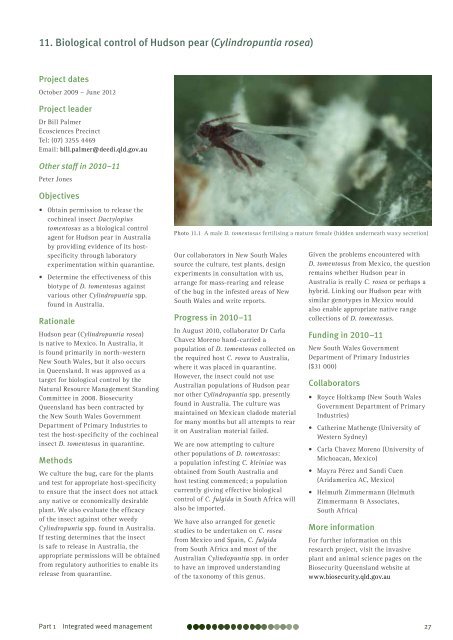Technical highlights - Department of Primary Industries ...
Technical highlights - Department of Primary Industries ...
Technical highlights - Department of Primary Industries ...
You also want an ePaper? Increase the reach of your titles
YUMPU automatically turns print PDFs into web optimized ePapers that Google loves.
11. Biological control <strong>of</strong> Hudson pear (Cylindropuntia rosea)<br />
Project dates<br />
October 2009 – June 2012<br />
Project leader<br />
Dr Bill Palmer<br />
Ecosciences Precinct<br />
Tel: (07) 3255 4469<br />
Email: bill.palmer@deedi.qld.gov.au<br />
Other staff in 2010–11<br />
Peter Jones<br />
Objectives<br />
• Obtain permission to release the<br />
cochineal insect Dactylopius<br />
tomentosus as a biological control<br />
agent for Hudson pear in Australia<br />
by providing evidence <strong>of</strong> its hostspecificity<br />
through laboratory<br />
experimentation within quarantine.<br />
• Determine the effectiveness <strong>of</strong> this<br />
biotype <strong>of</strong> D. tomentosus against<br />
various other Cylindropuntia spp.<br />
found in Australia.<br />
Rationale<br />
Hudson pear (Cylindropuntia rosea)<br />
is native to Mexico. In Australia, it<br />
is found primarily in north-western<br />
New South Wales, but it also occurs<br />
in Queensland. It was approved as a<br />
target for biological control by the<br />
Natural Resource Management Standing<br />
Committee in 2008. Biosecurity<br />
Queensland has been contracted by<br />
the New South Wales Government<br />
<strong>Department</strong> <strong>of</strong> <strong>Primary</strong> <strong>Industries</strong> to<br />
test the host-specificity <strong>of</strong> the cochineal<br />
insect D. tomentosus in quarantine.<br />
Methods<br />
We culture the bug, care for the plants<br />
and test for appropriate host-specificity<br />
to ensure that the insect does not attack<br />
any native or economically desirable<br />
plant. We also evaluate the efficacy<br />
<strong>of</strong> the insect against other weedy<br />
Cylindropuntia spp. found in Australia.<br />
If testing determines that the insect<br />
is safe to release in Australia, the<br />
appropriate permissions will be obtained<br />
from regulatory authorities to enable its<br />
release from quarantine.<br />
Photo 11.1 A male D. tomentosus fertilising a mature female (hidden underneath waxy secretion)<br />
Our collaborators in New South Wales<br />
source the culture, test plants, design<br />
experiments in consultation with us,<br />
arrange for mass-rearing and release<br />
<strong>of</strong> the bug in the infested areas <strong>of</strong> New<br />
South Wales and write reports.<br />
Progress in 2010–11<br />
In August 2010, collaborator Dr Carla<br />
Chavez Moreno hand-carried a<br />
population <strong>of</strong> D. tomentosus collected on<br />
the required host C. rosea to Australia,<br />
where it was placed in quarantine.<br />
However, the insect could not use<br />
Australian populations <strong>of</strong> Hudson pear<br />
nor other Cylindropuntia spp. presently<br />
found in Australia. The culture was<br />
maintained on Mexican cladode material<br />
for many months but all attempts to rear<br />
it on Australian material failed.<br />
We are now attempting to culture<br />
other populations <strong>of</strong> D. tomentosus:<br />
a population infesting C. kleiniae was<br />
obtained from South Australia and<br />
host testing commenced; a population<br />
currently giving effective biological<br />
control <strong>of</strong> C. fulgida in South Africa will<br />
also be imported.<br />
We have also arranged for genetic<br />
studies to be undertaken on C. rosea<br />
from Mexico and Spain, C. fulgida<br />
from South Africa and most <strong>of</strong> the<br />
Australian Cylindopuntia spp. in order<br />
to have an improved understanding<br />
<strong>of</strong> the taxonomy <strong>of</strong> this genus.<br />
Given the problems encountered with<br />
D. tomentosus from Mexico, the question<br />
remains whether Hudson pear in<br />
Australia is really C. rosea or perhaps a<br />
hybrid. Linking our Hudson pear with<br />
similar genotypes in Mexico would<br />
also enable appropriate native range<br />
collections <strong>of</strong> D. tomentosus.<br />
Funding in 2010–11<br />
New South Wales Government<br />
<strong>Department</strong> <strong>of</strong> <strong>Primary</strong> <strong>Industries</strong><br />
($31 000)<br />
Collaborators<br />
• Royce Holtkamp (New South Wales<br />
Government <strong>Department</strong> <strong>of</strong> <strong>Primary</strong><br />
<strong>Industries</strong>)<br />
• Catherine Mathenge (University <strong>of</strong><br />
Western Sydney)<br />
• Carla Chavez Moreno (University <strong>of</strong><br />
Michoacan, Mexico)<br />
• Mayra Pérez and Sandi Cuen<br />
(Aridamerica AC, Mexico)<br />
• Helmuth Zimmermann (Helmuth<br />
Zimmermann & Associates,<br />
South Africa)<br />
More information<br />
For further information on this<br />
research project, visit the invasive<br />
plant and animal science pages on the<br />
Biosecurity Queensland website at<br />
www.biosecurity.qld.gov.au<br />
Part 1 Integrated weed management 27

















